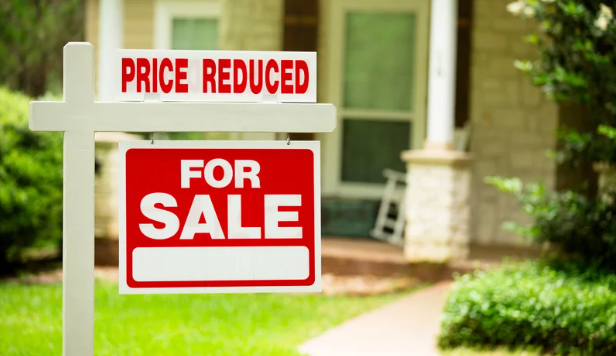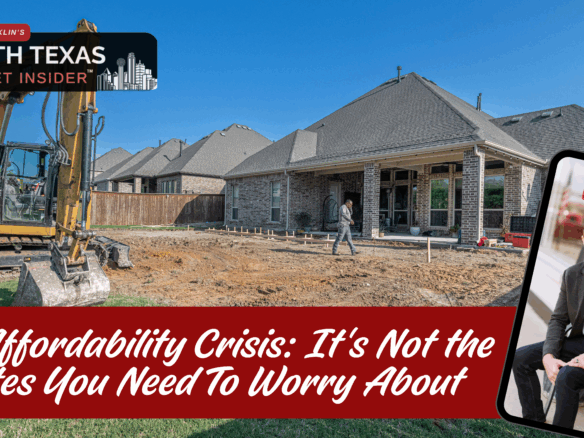Let me be direct with you: while everyone’s panicking about falling home values across Dallas-Fort Worth, I’m seeing something completely different. I’m seeing opportunity.
Zillow’s latest study shows 87% of DFW homes have declined in value over the past year. Dallas down 4.6%. Fort Worth down 3.7%. The typical home in the metroplex now sits at $370,384, the weakest performance since 2010.
Most agents read that and think problem. I read it and think positioning.
Because here’s what that data actually tells us: the market is finally resetting to where real people can actually buy homes again. And if you understand what’s happening underneath those numbers, you’re about to be five steps ahead of everyone still reading headlines.
The Real Story Behind the Numbers

Let’s talk about what actually drove these declines, because the “why” tells you everything about what comes next.
Affordability Finally Hit the Wall
During the pandemic, DFW home values went completely vertical. We’re talking 22.4% appreciation in 2022 alone, following 19.6% in 2021. That kind of growth was never sustainable because it completely disconnected from what people actually earn.
The home value-to-income ratio in Dallas County hit 4.1, meaning the typical home costs more than four times the median household income. By historical standards, that signals the market was overvalued by roughly 21.5%.
Markets don’t stay overvalued forever. They correct. That’s exactly what we’re watching.
The Rate Reality
Yes, mortgage rates above 6.5% are painful compared to those sub-3% pandemic rates. But here’s what most people miss: rates are actually down from the 7%+ peaks we saw in 2023.
The Federal Reserve’s trajectory suggests continued easing. When rates approach 6%, an estimated 5.5 million additional households will qualify for median-priced homes nationwide. That’s not a prediction, that’s math.
Inventory Exploded
Active listings across DFW submarkets are up 32% year-over-year. Where did all these homes come from?
Three places: new construction finally delivering units that were started during the boom, homeowners who delayed selling during the pandemic finally pulling the trigger, and reduced demand creating backlog as buyers wait on the sidelines.
With approximately five months of inventory now on the market, historically considered the equilibrium point between buyer and seller leverage, we’re approaching a balanced market for the first time in years. Check the Texas Real Estate Research Center for the latest monthly housing reports across DFW counties.
The Property Tax Squeeze
Here’s something that doesn’t get enough attention: Dallas County ranks seventh nationally in property tax burden. Property tax bills here have increased 41% over the past five years, with the average homeowner now paying around $570 monthly in property taxes alone.
That carrying cost matters. It affects affordability calculations. And it’s one reason smart buyers right now are exploring property tax exemptions and protests as part of their purchasing strategy.
What This Means for Current Homeowners

If you already own a home in DFW, here’s my strategic assessment:
Your Equity Position Matters More Than Headlines
Home equity is the difference between your property’s market value and your outstanding mortgage balance. Yes, declining values erode equity. But context matters enormously here.
If you purchased before 2021, you still likely hold substantial equity despite recent declines. DFW appreciated 120.45% over the past decade according to NeighborhoodScout’s analysis. A 4-5% pullback doesn’t erase that.
If you purchased at peak prices in 2021-2022 with minimal down payment? That’s a different conversation, and one worth having with a professional who can analyze your specific numbers.
The Property Tax Opportunity
Declining home values create one clear opportunity: property tax protests. As market values decrease, your assessed value should eventually reflect that—but appraisal districts lag behind market changes.
The Dallas Central Appraisal District and Ellis County Appraisal District both have protest processes. If your assessed value exceeds what comparable properties are actually selling for, you have grounds to challenge it. Successful protests can reduce your tax burden for years.
When to Sell vs. When to Hold
Sell if: Job relocation requires it. Life changes (divorce, health, growing family) necessitate different housing. You’re struggling with payments and need to exit before the situation worsens. You’ve held long-term and can still execute a profitable downsize.
Hold if: You purchased with a long-term horizon and can comfortably afford your mortgage. You’re locked into a low rate from 2020-2021 and would re-enter at today’s rates. You have substantial accumulated equity and no urgent need to move.
Real estate is cyclical. DFW’s fundamentals remain strong. Riding out a temporary correction usually beats panic selling, but every situation is different.
The Buyer’s Strategic Window

Now here’s where this gets interesting for anyone looking to purchase.
What You’re Getting Right Now
Negotiating leverage you haven’t had in years. More than 11,000 DFW homes have taken price reductions. Properties are averaging 53-59 days on market across counties. Sellers who listed expecting 2021 conditions are adjusting expectations.
Motivated sellers offering concessions. Closing cost coverage. Rate buydowns. Repair credits. The kinds of negotiation wins that were impossible 18 months ago are happening daily right now.
Improving rate environment. Current rates around 6.5% represent meaningful improvement from 2023’s peaks. That translates to $200-250 per month in savings on a typical DFW mortgage compared to last year.
Pricing stability ahead. Most forecasts(including Zillow’s projections) predict only modest additional declines of 2-3% through mid-2026 before stabilization. You’re not catching a falling knife; you’re buying near the bottom of a correction.
The New Construction Play
Here’s where I see particularly strong opportunity: new construction.
Builders facing slower demand are offering significant incentives. We’re talking closing cost coverage of $10,000-15,000. Rate buydowns of 2-3 percentage points for two to three years, some even permanent. Upgraded finishes at no additional cost.
Stack those up and you’re looking at $40,000-$80,000 in effective value on a typical new home purchase. Communities across Ellis County, Myrtle Creek Farms, Lakeway Estates, developments in Midlothian and Red Oak, are offering these kinds of deals right now.
The Texas Real Estate Commission has resources for understanding builder contracts and your rights as a buyer in new construction transactions.
The Strategic Timing Question
Should you wait for the “perfect” bottom?
Here’s the problem with that thinking: you’re not the only one waiting. When mortgage rates drop toward 6%, millions of sidelined buyers re-enter the market simultaneously. Competition returns. Prices stabilize and then appreciate. Seller concessions disappear.
The strategic window is now, when you have leverage, inventory, and motivated sellers all working in your favor. Trying to time the absolute bottom usually means missing the opportunity entirely.
What’s Coming: The 2026 Outlook

Looking ahead through 2026, here’s my read on where this market is heading:
Near-Term: Continued Soft Landing
Expect another 2-3% of modest price softening over the next 12 months before stabilization. Total peak-to-trough decline of 5-7%, meaningful but nowhere near 2008 crisis territory.
For context: Austin is forecast to drop 4.2% and San Antonio 3.2% by May 2026. DFW is performing in line with major Texas metros, not worse.
Mid-Term: Rebalancing Completes
The market is transitioning to equilibrium after years of severe inventory shortages and extreme seller advantage. With five months of inventory, we’re approaching historical norms where neither buyers nor sellers hold overwhelming leverage.
This is a healthy market. Not a broken one.
Long-Term: DFW Fundamentals Remain Strong
The Urban Land Institute recently named Dallas-Fort Worth the nation’s top real estate market to watch in 2026. Why?
Diverse economy that doesn’t depend on any single industry. Relative affordability compared to coastal markets (even after pandemic appreciation). Continued population growth and corporate relocations. Infrastructure investment including the Texas Central Railway and DFW Airport expansion.
The National Association of REALTORS forecasts national home sales will increase 14% in 2026 as mortgage rates ease to around 6%. DFW is positioned to capture disproportionate share of that activity.
Your Action Items Right Now

If You’re a Current Homeowner:
Maintain your property. Regular maintenance and strategic improvements preserve value even in declining markets. Focus on high-impact work: exterior condition, landscaping, essential systems.
Document everything. Keep detailed records of all improvements, repairs, and maintenance. When market conditions improve and you eventually sell, this documentation helps justify pricing.
Evaluate your tax assessment. Compare your assessed value against actual comparable sales. If your assessment exceeds market reality, file a protest during the appropriate window.
Build equity through principal reduction. Even as property values declined 4.6% this year, homeowners who made consistent mortgage payments gained equity through principal paydown. That forced savings mechanism remains one of homeownership’s greatest benefits.
If You’re Looking to Buy:
Get pre-approved now. Not pre-qualified, pre-approved. It clarifies your budget, signals seriousness to sellers, and lets you act decisively when you find the right property. I work with Denise Donoghue at The Mortgage Nerd and Andrew Bryan with Miramar Mortgage for clients who want strategic rate analysis and creative loan structuring.
Explore first-time buyer programs. Dallas and Fort Worth offer various programs including down payment assistance of $15,000-$30,000, favorable loan terms, and tax credits. The Texas State Affordable Housing Corporation has program details and eligibility information.
Be prepared to negotiate. Unlike 2021-2023 when homes sold above asking with multiple offers, current conditions allow real negotiation. Most homes with price reductions are selling 5-10% below original asking price.
Consider the builder incentive opportunity. New construction with rate buydowns and closing cost coverage can deliver better effective value than resale properties in many cases. Do the math on total cost of ownership, not just purchase price.
The Bottom Line

Nearly 87% of DFW homes losing value sounds scary. I get it.
But here’s what I know after tracking this market daily: chaos is where opportunity lives. Markets that feel uncomfortable are markets where strategic buyers and sellers win. Markets that feel easy are markets where you pay premium prices and accept whatever terms you’re given.
The DFW market is resetting to sustainable levels. Affordability is improving. Inventory is healthy. Rates are trending down. Long-term fundamentals remain among the strongest in the country.
Whether you should buy, sell, or hold depends entirely on your specific situation, your timeline, your financial position, your goals. But anyone telling you to panic about these numbers isn’t reading them correctly.
This is a market to take advantage of. Not a market to fear.

📊 Your North Texas market intel source
🎯 Text 214-228-0003 for insider updates
Bobby Franklin – REALTOR®
Legacy Realty Group – Leslie Majors Team
Serving Ellis County & DFW






Join The Discussion